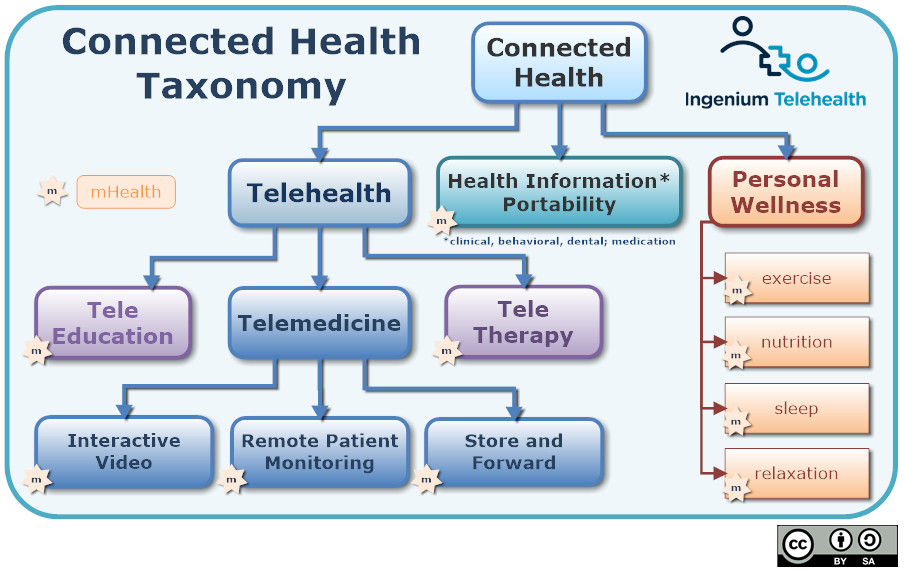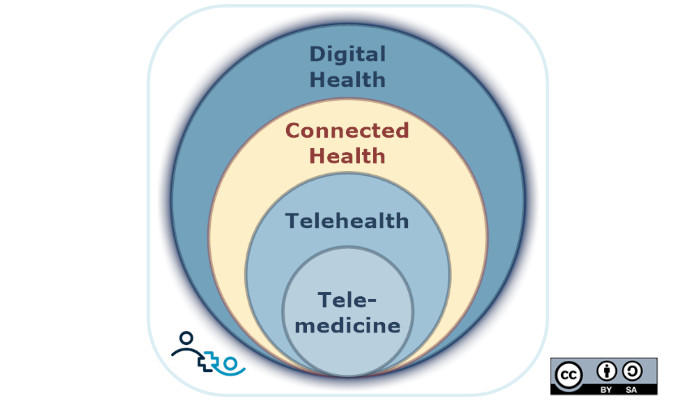“No man is an island, entire of itself.”
― John Donne
These days it seems that every week a new star or galaxy is discovered in the Digital Health universe. Social and internet media are abuzz with new terms, mostly without a clear definition and often used in conflicting ways: connected health, precision medicine, remote patient monitoring, quantified self, video visits, etc.
In the first part of this 3-part series, I made a case for why clear definitions can help all of us who are in the burgeoning digital health industry to improve the speed of progress. I also covered the definitions for telehealth and telemedicine and its different modes – interactive telemedicine, store & forward, and remote monitoring.
Telemedicine, i.e., practicing medicine at a distance, is the first link between traditional healthcare and digital healthcare, and it has been around since the widespread adoption of the telephone. By now we all intuit that virtual visits and remote interactions with providers, without the need for a clinic visit, will become the norm for non-urgent care and even for urgent care triage.
Over the past decades, with the advancement of technology in all aspects of our lives, new terms, new concepts have been emerging at a rapid pace. For the purpose of illustration, the higher up we go in the taxonomy hierarchy, the more we are leaving the traditional healthcare model. We are expanding our healthcare universe. Not only is this expansion a reflection of our improved technical capabilities, it also reflects our shift to a consumer-driven, consumer-empowered service economy that now affects all industries. We, as a society, as healthcare consumers, are increasingly involved in our care.
So let me build on the taxonomy from the first article and expand the Digital Health Universe beyond the Telehealth galaxy to include Connected Health. As the graphic below illustrates, Connected Health includes Telehealth, Personal Wellness and, most importantly, Health Information Portability.



Connected Health is a vision, a new model for managing people’s health.
It transcends episodic care and takes a more comprehensive and a more long-term view.
In a Connected Health world, providers, caregivers and patients have access to the right information at the right time in the right form to make better decisions. Connected Health not only connects providers to patients (as in Telehealth), but also consolidates health-relevant information from multiple sources inside and outside the system, to inform decision making. Ultimately, better outcomes are about better decision making — including the decisions patients make.
Connected Health is the vision of knowledge-driven care: a fully-networked healthcare system where patients and providers can easily connect with one another regardless of their location — doctors connecting with patients, generalists connecting with specialists, caregivers connecting with loved ones, etc. — and where all pertinent information (patient condition, health history, treatment options) is readily available to facilitate quality decision making.
The step from Telehealth to Connected Health is a big one and an evolution long in the making. No longer will technology be driving care (as did telecommunications technology), but rather the prefix “connected” focuses on relationships: relationships between people, interactions between systems, connections between information.
But that’s exactly the mindset I want my health system to be in, when I need it!
To make Connected Care happen, what we need most is the concept of Health Information Portability. At the current time, the free exchange of healthcare information is pretty much in its infancy. While the creation of Health Information Exchanges (HIEs) over the past years has moved us in the right direction, we are still very far from true portability of health information.
Interestingly enough, Apple just announced that it will expand its iOS HealthKit to allow the receipt and transmission of clinical data in the industry standard HL7. This “infrastructure” capability coupled with the widespread use of the iPhone could significantly move this aspect of the Connected Health forward.
Without portability, we cannot have truly connected care, since our care (and even more so maintaining our health) is currently infuriatingly fragmented across a multitude of service providers and personal activities.
Which brings me to the “newest kid on the block” in the Connected Care galaxy: Personal Wellness.
While a fringe group of “worried well” have always cared about (and tracked) their personal fitness (and, by extension, wellness), the tsunami of personal health apps with the mass spread of smartphones have created an unprecedented wealth of historical and anecdotal information. But this time in digital form. And if this information could be seamlessly integrated into the care providers’ decision making process, of course with appropriate filtering to ensure the high quality of the data, we would be one big step closer to realizing one part of the vision of truly connected care.
Where Connected Health differs from traditional care, is that it aims to leverage the knowledge generated across the whole spectrum of healthcare – whether that’s the patient-collected data from health apps, or digitally-available medical records from other providers and clinical data from tests in the recent or distant past.
The explosive interest in Personal Wellness over the last decade is a fascinating phenomenon, but it is also fraught with hype: by now it is public knowledge that most fitbit users, yours truly included, abandon its use within 3 months. Ultimately this explosion, however, is a reflection of our rapidly evolving attitude toward our health, our lifestyle, and our role in ensuring our well being. On the extreme end is the Quantified Self Movement and on the other end of the spectrum the casual user that might mostly be motivated by the social (media) peer pressure.
One motivation that all have in common though, is our frustration with the traditional healthcare system, whereas the use of health apps to advance our personal wellness gives us at least some sense of control.
Talking about apps, allow me a short discourse on one of the media’s most darling healthcare terms: mHealth or mobile health, is the collection of health or wellness-related apps that run on mobile platforms. As you can see by the little “m-stars” placed all over the Digital Health Taxonomy, mobile apps find their use in virtually any of the elements of the Connected Health and Telehealth Galaxies. Whether you are using an app to video chat (or text chat) with a provider, collect and record vital signs, watch a physical therapy video, read about your upcoming surgery in your hospital app, or track your latest exercise — “we’ve got an app for that”.
What I have found, though, is that in the media mHealth is mostly used synonymously for what I’ve defined as Personal Wellness above, probably because those apps of course have the greatest mass appeal. But the use of mobile technology to enable better care is not limited to any element of the Digital Health Universe. I suspect (or: I’m hopeful) that within the next couple of years the media will drop the term mHealth since it will become the defacto mechanism by which we use computing power and technology in healthcare. It’ll merely become the way to receive or manage our care.
Let me close by sharing that for me, Connected Health is the most exciting field to be in. Why? First of all, it encompasses a vision of a different health system, where the patient truly stands in the center and that gets me super excited about what the future holds.
But most importantly — and more about that in a future post — Connected Health’s ultimate outcome is that of “Empowered Wellness”.
I mentioned earlier that Connected Health is the vision of knowledge-driven care. In our traditional model that means that care providers will have the knowledge at the ready to provide the right care at the right time in the right location. But what if we free ourselves from the constraint of our current healthcare system? Could we, maybe, provide knowledge-driven care to ourselves? What if we had the knowledge to avoid care (excluding scenarios such as becoming willingly pregnant and getting unwillingly hit by a bus)?
What if Connected Care becomes the catalyst to fully realize the potential of Empowered Wellness, where we, the people, are empowered to take charge of our wellness? That’s a future that I’d like to see us create.
As I mentioned in the introduction, this is the second part of a 3-part series. In the next and last part I will complete painting the picture of the Digital Health universe, including Health IT and Precision Medicine. If you’d like a PDF of the first two parts, please reach out to me or request a copy in the comments below.








To receive articles like these in your Inbox every week, you can subscribe to Christian’s Telehealth Tuesday Newsletter.
Christian Milaster and his team optimize Telehealth Services for health systems and physician practices. Christian is the Founder and President of Ingenium Digital Health Advisors where he and his expert consortium partner with healthcare leaders to enable the delivery of extraordinary care.
Contact Christian by phone or text at 657-464-3648, via email, or video chat.







Leave A Comment